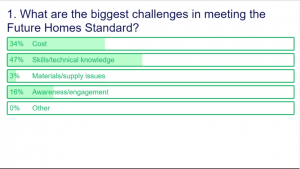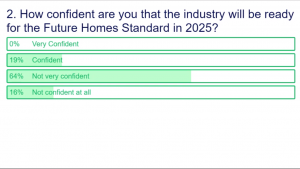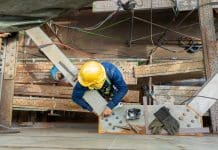On 8 Feb, PBC Today held the first in a new series of webinars with the Future Homes Standard – Next Steps on the Road to 2025
The government committed in the 2019 Spring Statement to introduce a Future Homes Standard by 2025 that will ensure new homes are “futureproofed with low carbon heating and world-leading energy efficiency”.
From 2025, it will require CO2 emissions from new build homes to be 75%-80% lower than previous standards, and dwellings will need to be “zero carbon ready” with no retrofit work required to connect to a decarbonised electricity grid.
In June 2022, an interim uplift in Building Regulations Approved Documents F (ventilation), and L (energy and carbon emissions) came into force, along with the new Parts O (overheating) and S (electric vehicles), as a step towards the standard. A full technical specification is expected to be published for consultation later this year.
Last month saw Mission Zero, the Independent Review of Net Zero by Chris Skidmore MP, call on the government to go “further and faster” on energy efficiency and reducing fossil fuel dependency, urging ministers to press ahead with the Future Homes Standard – and consider the introduction of a Net Zero Homes Standard by 2033.
Two years out, the momentum behind the Future Homes Standard seems to be building. It represents a step-change in how we plan, design and build homes – but this brings substantial challenges.
With this in mind, PBC Today’s expert panel explored the development of the Future Homes Standard, from its policy foundations to the “real world” impacts we are starting to see as we prepare for 2025.
We also had live polls looking at the barriers that need to be overcome for the industry and levels of confidence about being ready in time.


In addition, our viewers could put their questions to our experts in a live Q&A.
Joining PBC Today managing editor Andy Jowett were:
• Dr Gavin Dunn, CEO of the Chartered Association of Building Engineers (CABE) and chair of the Building Regulations Advisory Committee’s Future Homes Standard Working Group.
• John Askew, a regulatory specialist with Local Authority Building Control.
• Eddie Tuttle, director for policy, external affairs & research at the Chartered Institute of Building.
• Paul Jones, a director at the global architecture, engineering and consultancy company Ramboll.
Changes to the Future Homes Standard “are going to hit you much faster than changes in the past”
Discussing his work on the Future Homes Standard Working Group, Dr Gavin Dunn looked at the high-level concepts behind the policy and changes to the FLOS Building Regulations.
He stressed the importance of focusing on building fabric with insulation, careful detailing around thermal bridging, the right selection of materials and ensuring that what is built on-site matches the design performance set to be critical.
“If you take away only one thing from today’s webinar, the switch from gas to electricity as the primary source of heating our homes is fundamental and changes everything, and the transitional arrangements mean these changes are going to hit you much faster than changes in the past,” Dr Dunn said.
Implementation timeline of the Building Regulations
John Askew of LABC began by looking at the implementation timeline, from the interim uplift of the Building Regulations to full implementation of the FHS.
He also looked at the performance gap and the evidence that will be required to prove as-built performance.
Finally, he stressed the importance of interaction between Part O and Part F, as current design practice on overheating and ventilation makes problem cases more common.
There is a need for a radical national retrofit strategy
With our live poll showing a lack of skills as the biggest concern for our viewers in meeting the Future Homes Standard, Eddie Tuttle of the CIOB said a national skills strategy is long overdue.
And while the Future Homes Standard focuses on new builds, we must also focus on the performance of existing homes, he added.
“It we are to retrofit 29m existing homes by 2050, that’s a million a year or 20,000 each and every week, then we need a relevant national retrofit strategy that will be able to contribute to our legally binding carbon targets, but also create new jobs, deliver growth across the country and take many people out of fuel poverty,” he said.
What are the challenges surrounding awareness, viability and compliance with the Future Homes Standard?
Paul Jones of Ramboll discussed working with clients to prepare for the Future Homes Standard, as well as the challenges surrounding awareness, viability and compliance.
“This is a necessary step towards a low carbon future, but it’s happening at the same time as the Building Safety Act, the introduction of second staircases in buildings to address concerns around fire safety, inflationary pressures in the market, the cost of borrowing – all of these things make it really difficult,” he said.
Paul’s key message was that early engagement with the design team will be essential to ensure strategies are joined up.
The panel also took several questions from viewers, discussing everything from the challenges of delivery against ongoing skills shortages to the need for planning reform and the future of design and build contracts.
You can watch the full Future Homes Standard – Next Steps on the Road to 2025 webinar for free here.
















